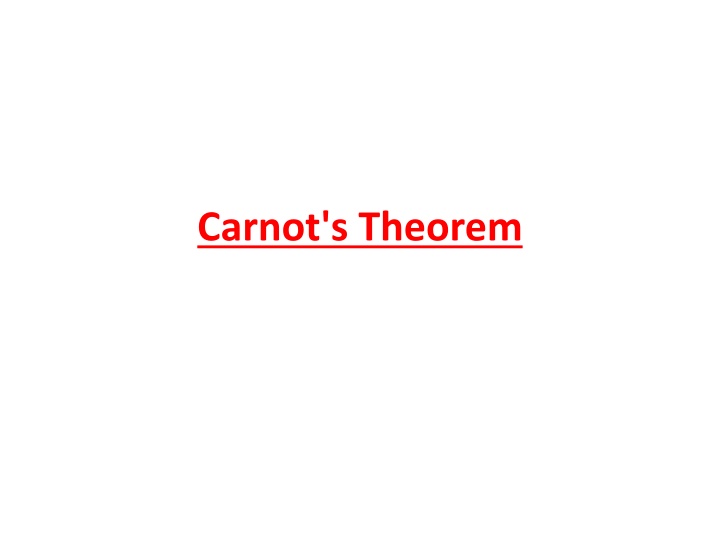
Contrary Conclusion: Carnot's Theorem on Engine Efficiency
Explore Carnot's Theorem and its implications from the perspective of the second law of thermodynamics. Discover how the efficiency of engines is limited by the concept of reversibility and temperature differentials.
Download Presentation

Please find below an Image/Link to download the presentation.
The content on the website is provided AS IS for your information and personal use only. It may not be sold, licensed, or shared on other websites without obtaining consent from the author. If you encounter any issues during the download, it is possible that the publisher has removed the file from their server.
You are allowed to download the files provided on this website for personal or commercial use, subject to the condition that they are used lawfully. All files are the property of their respective owners.
The content on the website is provided AS IS for your information and personal use only. It may not be sold, licensed, or shared on other websites without obtaining consent from the author.
E N D
Presentation Transcript
Statement From the second law of thermodynamics two important results are derived "No engine can be more efficient than a perfectly reversible engine working between the same two temperature. The efficiency ( ) of all reversible engines, working between temperatures is the same, whatever the working substance. the same two
First Part: To prove the first part of the theorem, we consider two engines R and I working between the temperatures T1and T2where T1> T2. Of these two engines R is reversible and I is irreversible, Suppose I is more efficient than R. Suppose in each cycle, R absorbs the quantity of heat Q1from the source at T1and rejects the quantity of heat Q2to the sink at T2.
Suppose in each cycle I absorbs the quantity of heat Q1 from the source at T1and gives up the quantity of heat Q2 to the sink at T2. Let the two engines do the same amount of work W in each cycle. According to the assumption I is more efficient than R.
Suppose the two engines are coupled together so that I drives R backwards they use the same source and sink. The combination forms a self-acting machine in which I supplies external work W and R absorbs this amount of work in its reverse cycle. I in its cycle absorbs heat Q1 from the source and gives up heat Q2 to the sink. R in its reverse cycle, absorbs heat Q2 from the sink and gives up heat Q, to the source.
Thus the coupled engines forming a self-acting machine unaided by any external agency transfer heat continuously from a body at low temperature to a body at a higher temperature.
This conclusion is contrary () to the second law of thermodynamics, According to which in a cyclic process heat cannot be transferred from one body to another at a higher temperature by a self-acting machine. Hence our assumption is incorrect and we conclude that no engine can be more efficient than a perfectly reversible engine working between the same temperatures.
Second Part: The second part of the theorem may be proved by the same arguments as before. For this purpose, we consider two reversible engines R1 and R2 and assume that R2 is more efficient than R1. Proceeding in the same way we can show that R2 cannot be more efficient than R1 .
Therefore, all reversible engines working between the same two temperatures have the same efficiency. Thus, the efficiency of a perfectly reversible engine depends only on the temperatures between which the engine work, and is independent of the nature of the working substance.













